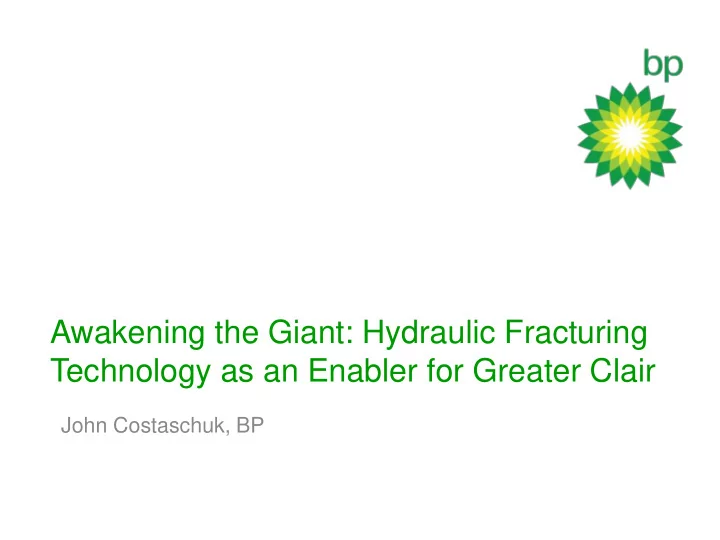

Awakening the Giant: Hydraulic Fracturing Technology as an Enabler for Greater Clair John Costaschuk, BP
Clair Field Overview • 75 km west of Shetland • 150m water depths • UK’s Largest known resource – 220 km2 (55,000 acres) – STOIIP c.7 billion barrels • Complex Field: – 500-800m of interbedded, fluvial sediments – Diagenetically altered Devonian sandstones (2-20mD) – Highly variable reservoir quality (moderate- poor) – Low API oil (24-21) … and naturally (or proppant!) fractured
Clair Appraisal & Development Vertical Appraisal Wells Campaign of several appraisal phases dating back to 1977 Vertical wells only drilled in first 15 years • Typically low PI associated with LCG matrix • Exception to this in 1991 with 206/8-8 hitting highly 1,000,000mD.ft fractured core of Clair Drill High-Angle Wells!!! Fractures!!
Clair Appraisal & Development Vertical High-Angle Appraisal Wells Appraisal Wells High-Angle Appraisal Wells drilled to test Fracture Deliverability • High PI (2 orders of magnitude greater than matrix) • EWT conducted that led to Phase 1 development
Clair Appraisal & Development Vertical High-Angle Development of Appraisal Wells Appraisal Wells naturally fractured areas Phase 1 Concept Development Phase 2 Phases Phase 3 Successful appraisal of Fracture Deliverability • Led to 2 phases of concept development – both leading to field development Greater Clair (green) tested dynamically and structurally interpreted as low likelihood of natural fracturing • How to develop this resource??!!
What are we trying to develop?
Clair South LCG ~750mmstb What are we trying to develop? Thickest column in Horst, 300+ m Column decreases going down-dip
Large Vertical Scale What are we trying to develop? 1 out of 6 units! 300ft 200ft Unit V 100ft
Permeability Heterogeneity What are we trying to develop? 1 Braided fluvial reservoirs Dykstra-Parsons Heterogeneity 0.9 • Deposits of high, variable energy 0.8 systems and poorly sorted, often Coefficient immature, sediments VI 0.7 V • Characterised by very variable 0.6 IV petrophysical properties III 0.5 • Fine-scale LCG matrix heterogeneity identified from a 0.4 206/8-1A 206/8-2 206/8-4 206/8-5 206/8-7 206/8-8 206/8-9 206/8-9Z 206/8-9Y 206/8-10Z 206/9-1 206/9-2 206/12-1 206/12-2 206/8-11A 206/8-11Z 206/8-12A 206/13-a2 206/8-13Z 206/8-14 206/8-15 206/8-A02 206/12a-3 large variance in permeability for a given porosity Core Permeability mD • Very high Dykstra-Parsons Heterogeneity Coefficients of 0.8 - 0.9 are calculated for all flow units, including the high NTG units (V/III), which indicate significant heterogeneity is present almost homogeneously. Core Porosity
Horizontal Permeability Horizontal permeability in Unit V relatively homogeneous at an inter-well scale • Dynamic KH ~5,000mD.ft repeatable across multiple well tests 5,000mD.ft • Static horizontal core ~20mD average x 250ft = 5,000mD.ft Well Test No problems horizontally! Vertically?? Continuous bulk KH 20mD non-net Horizontal Well Core Data in Unit V
Vertical Permeability Vertical permeability in Unit V relatively heterogeneous at a local scale • Static geometric average Kv <1mD • Low Kv/Kh ~0.005 Need for fractures vertically! Continuous bulk KH 20mD non-net Horizontal Well Core Data in Unit V
Hydraulic Fracturing Opportunity! Well 13a-2 (1992) Bilinear Flow => finite conductivity Pre-frac Uplift in Flow Capacity at 100hrs of 60% Post-frac • Pre-Frac => 5,800mD.ft • Post-Frac => 9,500mD.ft 5,800mD.ft 10 -1 10 -1 S Appraisal data demonstrates mechanism to 9,500mD.ft get through low Kv/Kh and contact full range of permeability BI-LINE BI-LINE 10 -2 10 -2 10 -2 10 -1 10 0 10 1 10 -2 10 -1 10 0 10 1 Delta-T (hr) Delta-T (hr)
How are we trying to develop it?
How to Prop Frac a Waterflood? How are we trying to develop it? Analogues
Reservoir Development Concepts How are we trying to develop it? RDC A Transverse RDC B Longitudinal Concept still evolving – reflects view at Concept Select
Reservoir Development Concepts How are we trying to develop it? Concept Select Base Case • 23 fracced wells in ~750mmstb STOIIP • Horizontal wells in combination with multi-stage hydraulic fracturing a significant value enhancement to the project: – Considerable acceleration in rate (+100%) – Uplift in UR of 50% from unfracced Risked Prop Frac Height? Oil Rate Cumulative Oil Production Well UR mmstb
Prop Frac Height – Geomech Basis How are we trying to develop it?
Benchmarking How are we trying to develop it? Clair Phase 1 – Fold of Increase, Waterflood Four stage development well due to be fracced summer 2019 SPE/Russia – FOI, Waterflood Khazzan – propped height
Summary What are we trying to develop? • The Lower Clair Group is thought to be unfractured in the Clair South development area, resulting in low average effective permeabilities (3-20mD) How are we trying to develop it? • 23 fracced wells in ~750mmstb STOIIP • Horizontal wells in combination with multi-stage hydraulic fracturing Reservoir Performance Prediction Hydraulic fracturing is a significant value enhancement to the project: • Considerable acceleration in early rate (+100%) • Uplift in UR of 50% from unfracced • Benchmarking: Clair (1992, 2019), Khazzan, Alaska, Russia What are the uncertainties? • Geological controls on propped frac growth due to stress contrasts (finescale mudstones, differential depletion) and leak-off (natural Clair fractures, faults, fracture complexity) South • Subsurface reservoir outcome (STOIIP, relperm, KH) • SIMOPS (deck space, weather windows, logistics, POB)
Acknowledgments • Clair Co-Venture Group: • BP Colleagues – Phil Whiteley, Prue Smith, Asif Hoq, Jim Briggs, Corrado Giuliani, Alistair Roy, Colin Slater, Dave Thrasher, Martin Rylance, Laurence Murray • JV Colleagues – John Braisby, Mensur Hodzic, Adam Beck, Kyle Metzgar, Frances Esson, Andrew Warnock, Wajahat Ali, Wiens van Zeil, James Churchill
Recommend
More recommend